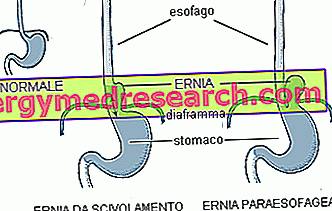What is Iatale Hernia
The hiatal hernia is caused by the passage of a portion of the stomach from the abdomen to the chest, through a hole in the diaphragm. This hole is called the esophageal diaphragmatic hiatus, precisely because in normal conditions it allows the passage of the esophagus through the diaphragm. In the case of a hiatal hernia, a more or less substantial part of the stomach rises up through this opening, causing the typical symptoms of the disease.
The hiatal hernia is a rather common pathology, since it affects on average about 15% of Italians.
Doctors distinguish three different types of hiatal hernias.

Types of Iatal Hernia
Sliding hernia
It is the most frequent (present in about 90% of cases); it is characterized by the passage of a portion of the stomach through the esophageal hiatus. The gastroesophageal junction is thus pushed upwards in many cases causing a disorder typical of the disease called gastroesophageal reflux .
Rolling or Paraesophageal hernia
More rare condition but also more dangerous than the previous one. In this case the junction between the stomach and the esophagus remains in its natural seat while the bottom of the stomach goes into the chest. The biggest drawback in this case is that the hernia ends up choking between the esophagus and the hiatus or that the supply of blood to the stomach is seriously compromised.Mixed Hernia
Type of hiatal hernia with characteristics of both previously described forms.Causes
Epidemiology and risk factors
The hiatal hernia is an age-related pathology, in fact approximately 25% of the population over the age of 50 suffers and almost 100% of the population over 80. The organic deterioration typical of aging, associated with the continuous repetition of movements typical of swallowing, it ends up altering the elasticity of the esophageal junction and hiatus, favoring herniation.
Women and the obese are more affected by hiatal hernia than their normal-weight peers. In children the presence of a hiatal hernia is almost always congenital and often occurs in association with other diseases.
Causes
Scholars have not yet found a unique explanation for the appearance of this pathology. Some people are affected by a hiatal hernia after suffering a severe abdominal trauma, others for congenital reasons related to the weakness or excessive opening of the esophageal hiatus.
The increase in abdominal pressure, as we have seen, favors the onset of the pathology. Chronic cough patients, pregnant women and overweight people are therefore more at risk.
Smoking, the habit of wearing tight clothes and old age also predispose the individual to the appearance of a hiatal hernia.
Hiatal hernia - Video: Causes, Symptoms, Cures
X Problems with video playback? Reload from YouTube Go to Video Page Go to Wellness Destination Watch the video on youtubeSymptoms
To learn more: hiatal hernia symptoms
The clinical picture of hiatal hernia is quite variable and while for some people the disease is completely asymptomatic for others it can cause more or less serious disorders. Often a patient occasionally discovers that he has a hiatal hernia during a visit related to other esophageal diseases.
If the hiatal hernia is rather large it can cause a reflux of the gastric chyme into the terminal part of the esophagus.
Between the esophagus and the stomach there is a special valve that in normal conditions opens and closes to allow the passage of the food bolus in a single direction. The diaphragm, with its pressure, favors the functioning of this mechanism, compressing and keeping the sphincter closed. When a hiatal hernia develops, the part of the stomach that comes out of its natural seat pushes the sphincter above the diaphragm, altering the normal opening and closing mechanism. This flap of muscle tissue can thus open even at the least opportune moments, causing the gastric contents to rise (acid pH 0.9 -3.5). This condition is called " gastro-oesophageal reflux syndrome".
Due to the extreme acidity of the gastric contents the oesophageal walls can be damaged causing the typical symptoms of the disease:
- severe chest pain and burning sensation in the sternum
- acid regurgitations
- sense of bitterness in the mouth
- intense salivation
- hoarseness
All these symptoms tend to appear or worsen during severe efforts or during pregnancy, due to the temporary increase in intra-abdominal pressure. The horizontal or "upside down" position (as when a shoe is fastened) further aggravates the typical symptoms of hiatal hernia.
Although there are effective drugs in treating this particular condition, surgical correction is sometimes used, especially if the hiatal hernia is very extensive. Some serious complications of hiatal hernia include the increased risk of developing stomach ulcer and esophageal cancer, breathing difficulties, anemia and blood loss with vomiting or faeces.
Those who suffer from hiatal hernia often experience a sense of chest tightness that can easily be confused with an anginal attack or a heart attack. This is also why early detection of the disease is very important.
If severe pain develops in the chest or abdomen associated with nausea, vomiting or a sense of gastric constriction, consult your doctor as soon as possible. It could in fact be a complication linked to a severe obstruction of blood flow to the stomach.



